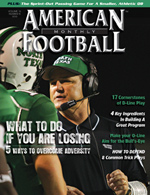Article CategoriesAFM Magazine
|
Speed Report: The History of Football Speed Training (Part I)by: Dale BaskettFootball Speed Specialist © More from this issue In the late seventies, into the early eighties, not much was taking place in the football speed world. In fact, before the early eighties, nothing formal was being done about speed development for football. By the eighties only some football programs had begun to consider speed training as a possible approach. For many years, coaches felt athletes either had speed or they didn’t. They were convinced that it couldn’t be developed. This concept was the main reason speed training was stagnant. Coaches go with trends; football speed development at the time didn’t have a force to spearhead a counter to the negatives that were prevalent regarding the potential of football speed. Finding the leaders who are creative and optimistic enough to pioneer a trend is usually not an easy task with any subject matter and speed was no ....The full article can only be seen by subscribers.
|
|
|||||||
| HOME |
MAGAZINE |
SUBSCRIBE | ONLINE COLUMNISTS | COACHING VIDEOS |
Copyright 2025, AmericanFootballMonthly.com
All Rights Reserved





